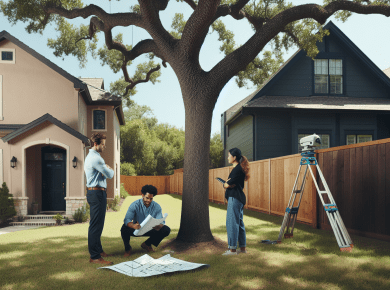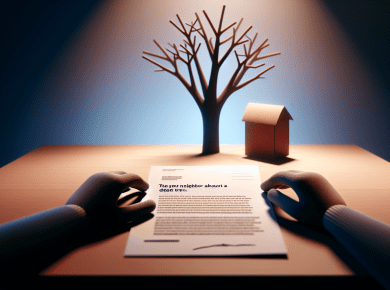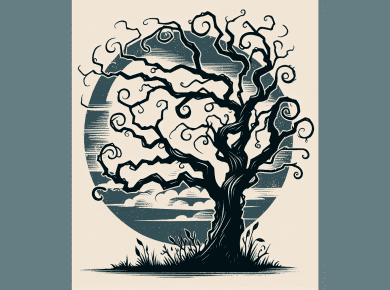Table of Contents
- A neighbor cut down my tree in Utah
- My neighbor cut my tree in Utah
- My tree branches overhang my property in Utah
- My neighbor damaged my tree on my property in Utah
- My neighbor’s tree roots or branches damaged my property in Utah
- Can my neighbor make me cut my tree?
- How can I get my neighbor to cut his dead tree in Utah?
- What happens if I cut my neighbor’s tree down in Utah?
- If a tree is cut down on my property by a neighbor how much money should I receive in damages?
A neighbor cut down my tree in Utah
If your neighbor chopped down your tree in Utah without your permission, you have legal recourse. It is illegal for anyone to cut down a tree that is on your property and doing so constitutes trespass and property damage in the State of Utah.
To start a legal case against your neighbor, you should first contact your local police department. They will be able to investigate the situation, gather evidence, and if appropriate, charge your neighbor with a crime.
You should also consult with a lawyer to see if you have a civil or criminal claim against your neighbor over the tree removal. A lawyer practicing in such cases will be able to gather evidence, negotiate with your neighbor, and if necessary, pursue legal action.
Many good lawyers for these cases are available in Utah. sites such as snapeservices.com provide an online platform for connecting customers and lawyers in the U.S, making it easy to find a lawyer for your tree-cutting case in Utah.
Once you find a lawyer, they can help you determine what the best course of action is to take in response to your neighbor’s tree removal. Depending on the unique circumstances, this could involve seeking compensation for the removal of the tree, filing a restraining order, or pursuing criminal charges.
No matter what you decide, it is important that you follow legal protocol and maintain your rights. When it comes to having a neighbor cut down your tree in Utah without permission, a good lawyer is essential.
My neighbor cut my tree in Utah
If your neighbor has cut down your tree in Utah without your permission, there are certain steps you can take to protect your tree and your rights as the tree’s owner. Here are some helpful tips to consider when facing such a situation:
1. Document the incident. Take pictures and make notes of the tree being cut, the surrounding scene, and any other important details. This will help you create a written record of what happened that later may be used to prove your case in court.
2. Speak to your neighbor. If possible, try to speak directly to your neighbor about the incident. Let them know that you are the owner of the tree, that you did not give them permission to remove it, and that you expect to be compensated for any damages.
3. Contact a lawyer. If talking with your neighbor does not resolve the issue, or if it makes you feel uncomfortable, it is a good idea to contact a lawyer and see what your rights are under Utah State law. A lawyer who is experienced in property law can help you understand your options, craft a demand letter, or even represent you in court.
4. Consider reparations. Depending on the circumstances, it is possible that you may be able to agree to an out-of-court settlement with your neighbor where they cover your losses. This could include compensating you for the value of the tree and helping to cover any related fees, such as clean up and landscaping.
By taking the right steps, you can protect your rights as a tree owner in Utah and help to ensure that your neighbor respects your property in the future.
My tree branches overhang my property in Utah
If you live in Utah, it is possible for your tree branches to overhang your property. There are several things to consider when dealing with this issue.
First, if your neighbor’s tree is encroaching on your property line, you are allowed to trim the branches that come onto your land. You must, however, be sure to only trim the parts of the branch that are overhanging onto your property. Do not trim branches that are still within the property line belonging to your neighbor.
Second, make sure you are using the proper tools when trimming the branches. A chainsaw or a handsaw might be necessary depending on the size of the branch. You also want to make sure you are wearing protective gear, like work gloves and eyewear, while trimming. Additionally, you should avoid cutting off large branches all at once. Instead, you should make multiple smaller cuts to reduce the risk of further damage to the tree.
Lastly, keep in mind that it is your responsibility to dispose of the trimmings. You should try to chip the branches or gather them up to be used for mulch in a garden or compost pile. If that is not an option, contact your local waste company to see if they have a pickup service for green waste.
In general, if you are dealing with tree branches encroaching on your property, be sure to use best practices when trimming them and to keep the environment in mind when disposing the trimmings. Doing so will ensure that any maintenance does not damage the tree and that your land remains in good condition.
My neighbor damaged my tree on my property in Utah
Dealing with a neighbor who has damaged a tree on your property in Utah can be a tricky affair. Here is a guide on how to handle the situation.
1. Check your state’s local laws. In Utah, 13-20-3 states that it is illegal to intentionally damage a tree or shrub that is protected by law or is on public or private property.
2. Gather evidence. If you think that your neighbor has damaged the tree on your property, it’s important to document what has happened. Take pictures of the damage, if possible, and keep any other evidence, such as bits of the tree or broken branches.
3. Speak to your neighbor about the damage. If you can, try to have a calm conversation with your neighbor about the situation and the damage that has been caused to the tree on your property. This will help to start the process of resolving the issues and may help to take the situation away from being a heated dispute between neighbors.
4. Contact the police. If your neighbor is uncooperative or if you feel that the situation has become dangerous, then you should contact the local police department.
5. Contact a lawyer. If the dispute over the damaged tree escalates, it may be necessary to contact a lawyer. An attorney can advise you on what steps to take and can help to enforce your legal rights if the matter is taken to court.
In summary, if your neighbor has damaged a tree on your property in Utah, then it’s important to document the damage, check the local laws, and try to speak to your neighbor about the issue. If the situation becomes dangerous or escalates beyond your control, then contact the police and consider consulting with a lawyer.
My neighbor’s tree roots or branches damaged my property in Utah
If you live in Utah and your neighbor’s tree roots or branches are causing damage to your property, you have a few options.
First, you should talk to your neighbor to see if you can work out a solution. Regardless of how amicable the relationship between you two is, it’s best to approach the situation calmly and reasonably. Explain the situation and suggest a solution, such as trimming back the branches or exploring a way to minimize the root growth.
If your neighbor is unwilling to work with you, then you may want to consider speaking to an attorney. Depending on the situation, you may have legal grounds to seek damages from the neighbor if their carelessness causes harm to your property.
Lastly, if it is your neighbor’s tree, you may not be granted permission to trim or remove it. In many regions, trees on a neighbor’s property are considered to be part of the neighbor’s land and require permission to trim or remove.
Regardless of the route you take, you may want to contact a qualified arborist or tree service to assess the tree and give you an opinion and estimate if trimming or removing the tree is necessary.
Finally, it’s important to stay civil and cordial during the entire process. You may be able to work out a solution with your neighbor without having to go through the courts or hiring an attorney. If the process does take a legal turn, remember to stay calm and follow all legal advice and procedures.
Can my neighbor make me cut my tree?
Cutting down your tree without your permission is against the law, in most areas. In general, if you own your tree, it is considered your property. This means that a neighbor can not make you cut it.
However, there may be cases when a neighbor can show that your tree is causing a nuisance. This could include causing a lot of shade, blocking out sunlight or blocking a view.
If a neighbor can prove that your tree is causing problems and is damaging their property, then they may be able to seek court orders to have it removed.
It’s best to discuss the situation with your neighbor to try and work something out. They might want to trim or cut some branches or they might want to cut down the entire tree. It’s important to discuss this with them in an amicable manner.
If their claims are found to be reasonable, then state laws will usually allow a court to order the tree’s partial or complete removal. Depending on the circumstances, you may be able to negotiate a settlement where they pay for the removal or pay a fee in exchange for the tree staying.
Each state has specific laws regarding trees and disputes between neighbors. It’s best to consult your local government or an attorney to find out more about the law in your area. This will help you make the best decision for your property and for the safety of your neighbor.
How can I get my neighbor to cut his dead tree in Utah?
1. Research laws regulating tree trimming and cutting. Seek help from a local tree care professional to verify if cutting your neighbor’s tree is allowed. In Utah, home and business owners are typically responsible for removing any dead trees or limbs on their property.
2. Talk to your neighbor. If their dead tree is near your home, yard, or business, explain your concern over it being potentially hazardous. They may be amenable to cutting it down. If your neighbor is hesitant or uncooperative, consider offering to pay for a portion or all of the tree removal cost as an incentive.
3. Contact local authorities. Depending on the size, location, and scope of the tree, you may need to involve local authorities such as the fire department or city council. If the tree is considered a safety risk due to the potential of falling limbs, they may be able to order its removal.
4. Initiate a civil court case. If your neighbor refuses to cut down the tree, contact an attorney and file a civil action against them. Depending on local laws, you may be able to recoup the cost of removing the tree.
5. Hire a tree care professional. If your neighbor still refuses to cut down their tree, you may have to take matters into your own hands. Find a reputable tree care professional and have them come to inspect the tree. If it is deemed hazardous or too close to your property, ask if they can safely remove the tree at a reasonable cost.
What happens if I cut my neighbor’s tree down in Utah?
If you cut down your neighbor’s tree in Utah without their permission, you risk facing numerous civil and criminal repercussions.
At a minimum, you would have to pay for the costs of replacement. You may also have to reimburse for additional damages that would include the loss of natural beauty, depriving your neighbor of their right to the tree’s shade, or even the inconvenience of clean up.
In addition, you may be required to pay a fine. Depending on the circumstances, you could face misdemeanor or felony criminal charges, which can lead to substantial fines, incarceration and probation. A felony charge can often result in hefty fines and up to 15 years of prison time.
The Utah government takes the protection of trees seriously and it would be wise to contact a qualified attorney right away if you did cut down your neighbor’s tree as a result of this mistake. With the right attorney and a good defense, the charges and fines may be reduced.
You can avoid these consequences altogether by respecting your neighbor’s property. Reach out and talk to them about any concerns you have with the tree. Communicate with your neighbor and try to come up with a solution that satisfies both parties.
Ultimately, cutting down your neighbor’s tree in Utah can have serious legal consequences. Make sure you understand the law and always check with your neighbor first if you have any concerns about the tree.
If a tree is cut down on my property by a neighbor how much money should I receive in damages?
The law outlines a procedure to be followed, and the outcome of that procedure will determine what damages should be awarded. In the first instance, you should write a letter to your neighbor asking them to provide an explanation for their actions and demanding that they pay damages.
If they fail to reply or do not agree with your assessment of damages, then you may need to commence legal proceedings against them. The court will assess the evidence and make a determination as to damages.
You could also consider reporting the incident to the police and having the matter dealt with through criminal proceedings. The maximum penalty for anyone who deliberately cuts down or destroys someone else’s protected tree is $220,000 or 5 years imprisonment or both.



